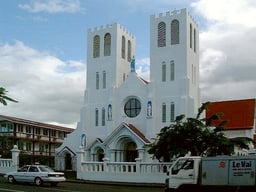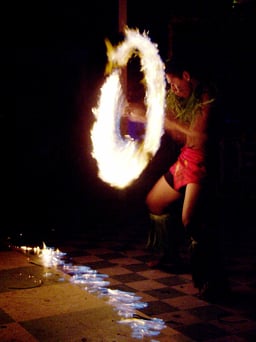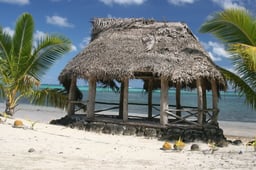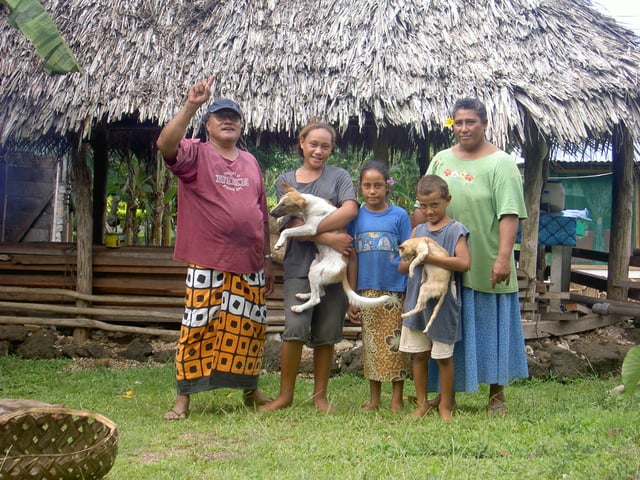Samoa
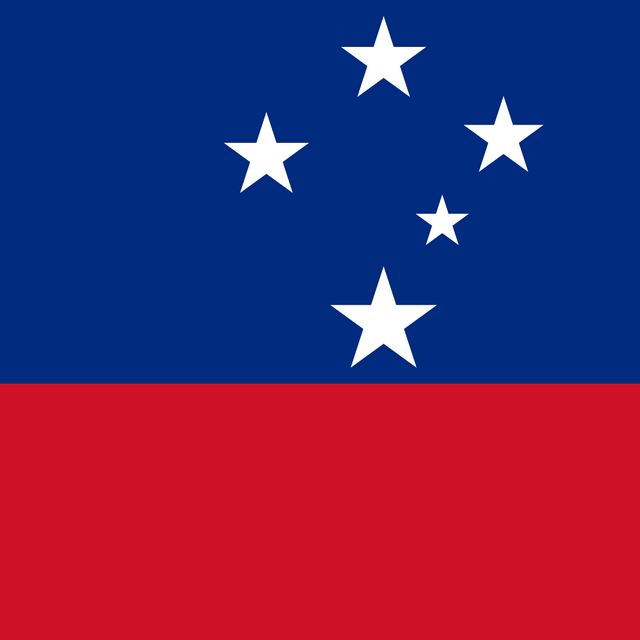
Samoa

| Capital | Apia |
|---|---|
| Official languages | |
| Ethnic groups | |
| Religion | Christianity(official)[2] |
| Demonym(s) | Samoan |
| Government | Unitarydominant-partyparliamentary democracyunder anelective monarchy |
| Va'aletoa Sualauvi II | |
| Tuilaepa Aiono Sailele Malielegaoi | |
| Legislature | Legislative Assembly |
| Independence fromNew Zealand | |
| 14 June 1889 | |
| 16 February 1900 | |
| 1 March 1900 | |
| 30 August 1914 | |
| 17 December 1920 | |
| 13 December 1946 | |
| 1 January 1962 | |
| 15 December 1976 | |
| Area | |
| 2,842 km(1,097 sq mi) (167th) | |
| 0.3 | |
| Population | |
| 195,843[3] | |
| 68/km(176.1/sq mi) | |
| GDP | 2018 estimate |
| $1.188 billion[4] | |
| $5,962[4] | |
| GDP | 2018 estimate |
| $881 million[4] | |
| $4,420[4] | |
| HDI | |
| Currency | Tālā(WS$) (WST) |
| Time zone | (WST) |
| (WST) | |
| Date format | DD/MM/YYYY |
| Driving side | left |
| Calling code | +685 |
| ISO 3166 code | WS |
| Internet TLD | .ws |
Samoa (/səˈmoʊə/), officially the Independent State of Samoa (Samoan: Malo Saʻoloto Tutoʻatasi o Sāmoa; Samoan: Sāmoa, IPA: [ˈsaːmoa]) and, until 4 July 1997, known as Western Samoa, is a country consisting of two main islands, Savai'i and Upolu, and four smaller islands (Manono, Apolima, Fanuatapu, and Namua). The capital city is Apia. The Lapita people discovered and settled the Samoan Islands around 3,500 years ago. They developed a unique Samoan language and Samoan cultural identity.
Samoa is a unitary parliamentary democracy with eleven administrative divisions. The country is a member of the Commonwealth of Nations. Western Samoa was admitted to the United Nations on 15 December 1976.[8] The entire island group, which includes American Samoa, was called "Navigator Islands" by European explorers before the 20th century because of the Samoans' seafaring skills.[9][10] The country was governed by New Zealand until its independence in 1962.
In July 2017, Va'aletoa Sualauvi II became the head of state, succeeding Tuiatua Tupua Tamasese Efi. The Prime Minister Tuila'epa came back to power after a landslide victory in March 2016, beginning a fifth term for the premier.[11]
| Capital | Apia |
|---|---|
| Official languages | |
| Ethnic groups | |
| Religion | Christianity(official)[2] |
| Demonym(s) | Samoan |
| Government | Unitarydominant-partyparliamentary democracyunder anelective monarchy |
| Va'aletoa Sualauvi II | |
| Tuilaepa Aiono Sailele Malielegaoi | |
| Legislature | Legislative Assembly |
| Independence fromNew Zealand | |
| 14 June 1889 | |
| 16 February 1900 | |
| 1 March 1900 | |
| 30 August 1914 | |
| 17 December 1920 | |
| 13 December 1946 | |
| 1 January 1962 | |
| 15 December 1976 | |
| Area | |
| 2,842 km(1,097 sq mi) (167th) | |
| 0.3 | |
| Population | |
| 195,843[3] | |
| 68/km(176.1/sq mi) | |
| GDP | 2018 estimate |
| $1.188 billion[4] | |
| $5,962[4] | |
| GDP | 2018 estimate |
| $881 million[4] | |
| $4,420[4] | |
| HDI | |
| Currency | Tālā(WS$) (WST) |
| Time zone | (WST) |
| (WST) | |
| Date format | DD/MM/YYYY |
| Driving side | left |
| Calling code | +685 |
| ISO 3166 code | WS |
| Internet TLD | .ws |
History
Early Samoa
New Zealand scientists have dated remains in Samoa to about 2900 years ago.
These were found at a Lapita site at Mulifanua and the findings were published in 1974.[12]
The origins of the Samoans are closely studied in modern research about Polynesia in various scientific disciplines such as genetics, linguistics and anthropology. Scientific research is ongoing, although a number of different theories exist; including one proposing that the Samoans originated from Austronesian predecessors during the terminal eastward Lapita expansion period from Southeast Asia and Melanesia between 2,500 and 1,500 BCE.[13]
Intimate sociocultural and genetic ties were maintained between Samoa, Fiji, and Tonga, and the archaeological record supports oral tradition and native genealogies that indicate inter-island voyaging and intermarriage between pre-colonial Samoans, Fijians, and Tongans.
Notable figures in Samoan history included the Tui Manu'a line and Queen Salamasina (15th century). Nafanua was a famous woman warrior who was deified in ancient Samoan religion.
Contact with Europeans began in the early 18th century.
Jacob Roggeveen, a Dutchman, was the first known European to sight the Samoan islands in 1722. This visit was followed by French explorer Louis-Antoine de Bougainville, who named them the Navigator Islands in 1768. Contact was limited before the 1830s, which is when English missionaries and traders began arriving.
Samoa in the 1800s
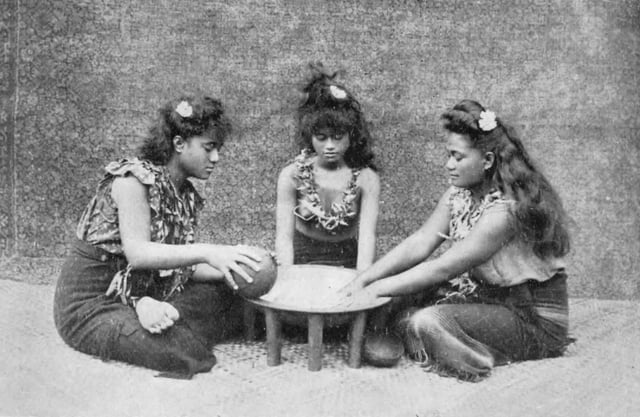
Studio photo depicting preparation of the Samoa 'ava ceremony c. 1911.
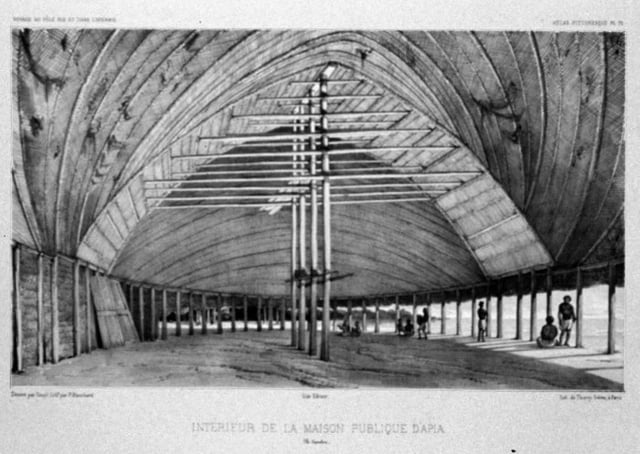
Interior of Samoan house, Apia, Urville 1842.
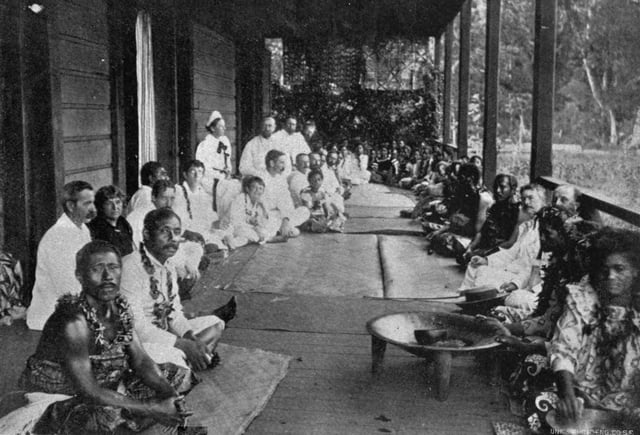
Robert Louis Stevenson's birthday fete at Vailima, 1894
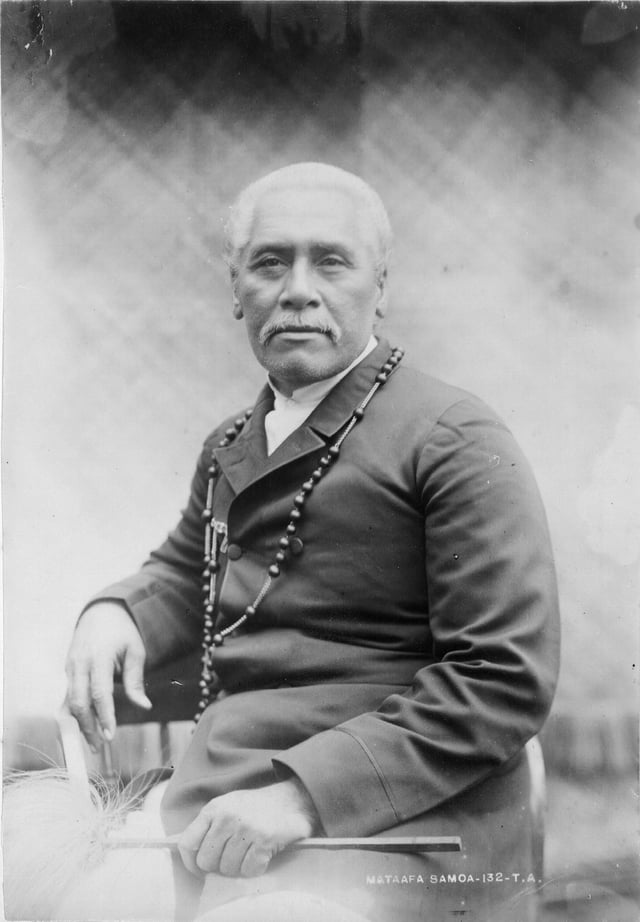
Mata'afa Iosefo (1832–1912) paramount chief and rival for the kingship of Samoa
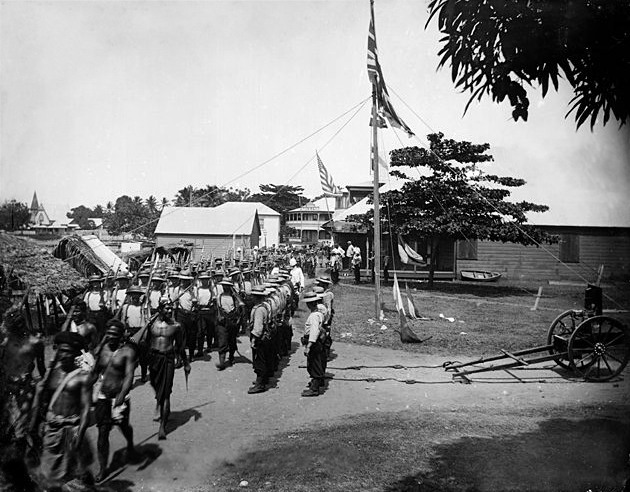
The joint commission of Germany, the United States and Great Britain abolished the Samoan kingship in June 1899
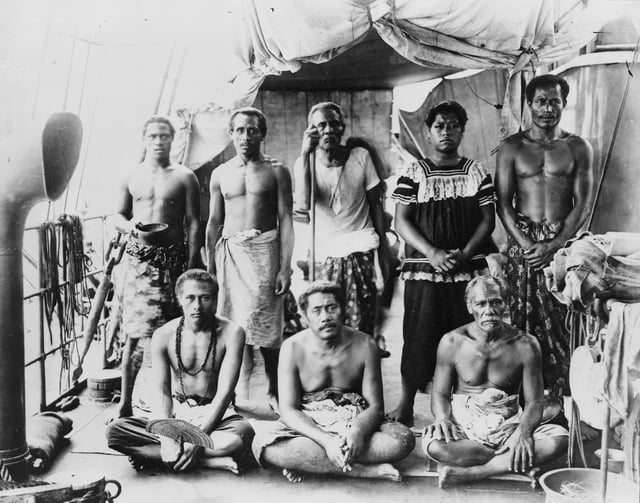
Exiled orator Lauaki Namulau'ulu Mamoe (standing 3rd from left with orator's staff) and other chiefs aboard German warship taking them to exile in Saipan, 1909
Visits by American trading and whaling vessels were important in the early economic development of Samoa. The Salem brig Roscoe (Captain Benjamin Vanderford), in October 1821, was the first American trading vessel known to have called, and the Maro (Captain Richard Macy) of Nantucket, in 1824, was the first recorded United States whaler at Samoa.[14] The whalers came for fresh drinking water, firewood and provisions, and later, they recruited local men to serve as crewmen on their ships.
Christian missionary work in Samoa began in 1830 when John Williams of the London Missionary Society arrived in Sapapali'i from the Cook Islands and Tahiti.[15] According to Barbara A. West, "The Samoans were also known to engage in ‘headhunting', a ritual of war in which a warrior took the head of his slain opponent to give to his leader, thus proving his bravery."[16] However, Robert Louis Stevenson, who lived in Samoa from 1889 until his death in 1894, wrote in A Footnote to History: Eight Years of Trouble in Samoa, "… the Samoans are gentle people."[17]
The Germans, in particular, began to show great commercial interest in the Samoan Islands, especially on the island of Upolu, where German firms monopolised copra and cocoa bean processing. The United States laid its own claim, based on commercial shipping interests in Pearl River in Hawaii and Pago Pago Bay in Eastern Samoa, and forced alliances, most conspicuously on the islands of Tutuila and Manu'a which became American Samoa.
Britain also sent troops to protect British business enterprise, harbour rights, and consulate office.
This was followed by an eight-year civil war, during which each of the three powers supplied arms, training and in some cases combat troops to the warring Samoan parties. The Samoan crisis came to a critical juncture in March 1889 when all three colonial contenders sent warships into Apia harbour, and a larger-scale war seemed imminent. A massive storm on 15 March 1889 damaged or destroyed the warships, ending the military conflict.[18]
The Second Samoan Civil War reached a head in 1898 when Germany, the United Kingdom, and the United States were locked in dispute over who should control the Samoa Islands. The Siege of Apia occurred in March 1899. Samoan forces loyal to Prince Tanu were besieged by a larger force of Samoan rebels loyal to Mata'afa Iosefo. Supporting Prince Tanu were landing parties from four British and American warships. After several days of fighting, the Samoan rebels were finally defeated.[19]
American and British warships shelled Apia on 15 March 1899, including the USS Philadelphia. Germany, the United Kingdom and the United States quickly resolved to end the hostilities and divided the island chain at the Tripartite Convention of 1899, signed at Washington on 2 December 1899 with ratifications exchanged on 16 February 1900.[20]
The eastern island-group became a territory of the United States (the Tutuila Islands in 1900 and officially Manu'a in 1904) and was known as American Samoa. The western islands, by far the greater landmass, became German Samoa. The United Kingdom had vacated all claims in Samoa and in return received (1) termination of German rights in Tonga, (2) all of the Solomon Islands south of Bougainville, and (3) territorial alignments in West Africa.[21]
German Samoa (1900–1914)
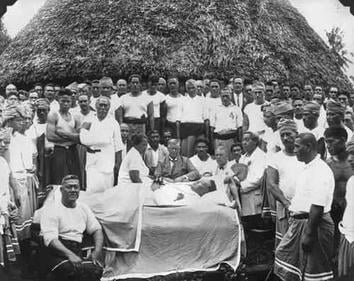
People in attendance at Tupua Tamesese's funeral.
The German Empire governed the western Samoan islands from 1900 to 1914.
Wilhelm Solf was appointed the colony's first governor. In 1908, when the non-violent Mau a Pule resistance movement arose, Solf did not hesitate to banish the Mau leader Lauaki Namulau'ulu Mamoe to Saipan in the German Northern Mariana Islands.[22]
The German colonial administration governed on the principle that "there was only one government in the islands."[23] Thus, there was no Samoan Tupu (king), nor an alii sili (similar to a governor), but two Fautua (advisors) were appointed by the colonial government. Tumua and Pule (traditional governments of Upolu and Savai'i) were for a time silent; all decisions on matters affecting lands and titles were under the control of the colonial Governor.
In the first month of World War I, on 29 August 1914, troops of the New Zealand Expeditionary Force landed unopposed on Upolu and seized control from the German authorities, following a request by Great Britain for New Zealand to perform this "great and urgent imperial service."[24]
New Zealand rule (1914–1962)
From the end of World War I until 1962, New Zealand controlled Samoa as a Class C Mandate under trusteeship through the League of Nations,[25] then through the United Nations. Between 1919 and 1962, Samoa was administered by the Department of External Affairs, a government department which had been specially created to oversee New Zealand's Island Territories and Samoa.[26] In 1943, this Department was renamed the Department of Island Territories after a separate Department of External Affairs was created to conduct New Zealand's foreign affairs.[27] During the period of New Zealand control, their administrators were responsible for two major incidents.
Flu pandemic
In the first incident, approximately one fifth of the Samoan population died in the influenza epidemic of 1918–1919.[28]
In 1918, during the final stages of World War I, the flu pandemic had taken its toll, spreading rapidly from country to country. American Samoa became one of only three places in the world (the others being New Caledonia and Marajó island in Brazil) to have prevented any deaths during the pandemic through the quick response from Governor John Martin Poyer after hearing news reports of the outbreak on the radio and requesting quarantine ships from the U.S. mainland. On Samoa, there had been no epidemic of pneumonic influenza in Western Samoa before the arrival of the SS Talune from Auckland on 7 November 1918. The NZ administration allowed the ship to berth in breach of quarantine; within seven days of this ship's arrival, influenza became epidemic in Upolu and then spread rapidly throughout the rest of the territory.[29] Samoa suffered the most of all Pacific islands, with 90% of the population infected; 30% of adult men, 22% of adult women and 10% of children died. The cause of the epidemic was confirmed in 1919 by a Royal Commission of Inquiry into the Epidemic concluded that there had been no epidemic of pneumonic influenza in Western Samoa before the arrival of the SS Talune from Auckland on 7 November 1918.[29]
Mau movement
The second major incident arose out of an initially peaceful protest by the Mau (which literally translates as "strongly held opinion"), a non-violent popular movement which had its beginnings in the early 1900s on Savai'i, led by Lauaki Namulauulu Mamoe, an orator chief deposed by Solf. In 1909, Lauaki was exiled to Saipan and died en route back to Samoa in 1915.
By 1918, Samoa had a population of some 38,000 Samoans and 1,500 Europeans.[30]
However, Samoans greatly resented New Zealand's colonial rule, and blamed inflation and the catastrophic 1918 flu epidemic on its misrule.[31] By the late 1920s the resistance movement against colonial rule had gathered widespread support.
One of the Mau leaders was Olaf Frederick Nelson, a half Samoan and half Swedish merchant.[32] Nelson was eventually exiled during the late 1920s and early 1930s, but he continued to assist the organisation financially and politically. In accordance with the Mau's non-violent philosophy, the newly elected leader, High Chief Tupua Tamasese Lealofi, led his fellow uniformed Mau in a peaceful demonstration in downtown Apia on 28 December 1929.[33]
The New Zealand police attempted to arrest one of the leaders in the demonstration.
When he resisted, a struggle developed between the police and the Mau.
The officers began to fire randomly into the crowd and a Lewis machine gun, mounted in preparation for this demonstration, was used to disperse the demonstrators.[34] Chief Tamasese was shot from behind and killed while trying to bring calm and order to the Mau demonstrators, screaming "Peace, Samoa". Ten others died that day and approximately 50 were injured by gunshot wounds and police batons.[35] That day would come to be known in Samoa as Black Saturday. The Mau grew, remaining steadfastly non-violent, and expanded to include the highly influential women's branch.
Independence (1962)
After repeated efforts by the Samoan independence movement, the New Zealand Western Samoa Act 1961 of 24 November 1961 granted Samoa independence, effective on 1 January 1962, upon which the Trusteeship Agreement terminated.[36][37] Samoa also signed a friendship treaty with New Zealand. Samoa, the first small-island country in the Pacific to become independent, joined the Commonwealth of Nations on 28 August 1970. While independence was achieved at the beginning of January, Samoa annually celebrates 1 June as its independence day.[38][39]
Travel writer Paul Theroux noted marked differences between the societies in Western Samoa and American Samoa in 1992.[40]
1997 name change
On 4 July 1997 the government amended the constitution to change the country's name from Western Samoa to Samoa.[43] American Samoa protested against the move, asserting that the change diminished its own identity.[44]
21st century
On 7 September 2009, the government changed the driving orientation for motorists: Samoans now drive on the left side of the road like in most other Commonwealth countries. This brought Samoa into line with many other countries in the region. Samoa thus became the first country in the 21st century to switch to driving on the left.[45]
At the end of December 2011, Samoa jumped forward by one day, omitting 30 December from the local calendar, when the nation moved to the west of the International Date Line.[46] This change aimed to help the nation boost its economy in doing business with Australia and New Zealand. Before this change, Samoa was 21 hours behind Sydney, but the change means it is now three hours ahead. The previous time zone, implemented on 4 July 1892, operated in line with American traders based in California.[47]
In 2017, Samoa signed the UN treaty on the Prohibition of Nuclear Weapons.[48]
Politics
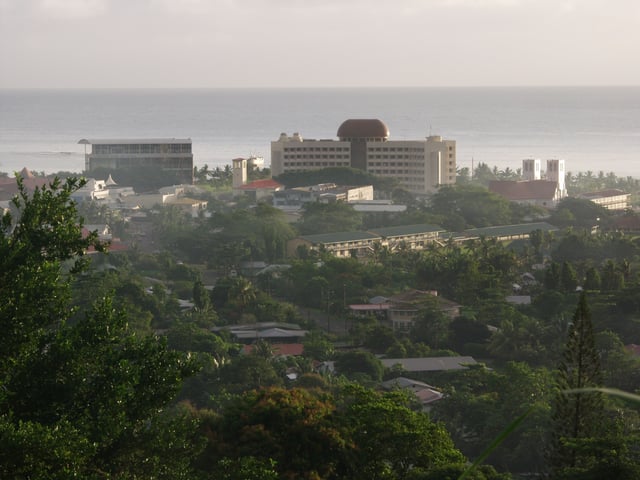
Government buildings in Apia.
The 1960 constitution, which formally came into force with independence from New Zealand in 1962, builds on the British pattern of parliamentary democracy, modified to take account of Samoan customs.[51] The national modern Government of Samoa is referred to as the Malo.
Fiame Mata'afa Faumuina Mulinu’u II, one of the four highest-ranking paramount chiefs in the country, became Samoa's first Prime Minister. Two other paramount chiefs at the time of independence were appointed joint heads of state for life. Tupua Tamasese Mea'ole died in 1963, leaving Malietoa Tanumafili II sole head of state until his death on 11 May 2007. The next Head of State, Tuiatua Tupua Tamasese Efi, was elected by the legislature on 17 June 2007 for a fixed five-year term,[52] and was re-elected unopposed in July 2012. Tufuga Efi was succeeded by Va'aletoa Sualauvi II in 2017.
The unicameral legislature (the Fono) consists of 49 members serving 5-year terms. Forty-seven are matai title-holders elected from territorial districts by Samoans; the other two are chosen by non-Samoans with no chiefly affiliation on separate electoral rolls.[53] Universal suffrage was adopted in 1990, but only chiefs (matai) may stand for election to the Samoan seats. There are more than 25,000 matais in the country, about 5% of whom are women.[54] The prime minister, chosen by a majority in the Fono, is appointed by the head of state to form a government. The prime minister's choices for the 12 cabinet positions are appointed by the head of state, subject to the continuing confidence of the Fono.
Prominent women in Samoan politics include the late Laulu Fetauimalemau Mata'afa (1928–2007) from Lotofaga constituency, the wife of Samoa's first prime minister. Their daughter Fiame Naomi Mata'afa is a paramount chief and a long-serving senior member of cabinet. Other women in politics include Samoan scholar and eminent professor Aiono Fanaafi Le Tagaloa, orator-chief Matatumua Maimoana and Safuneitu'uga Pa'aga Neri (as of 2016 the Minister of Communication and Technology).
The judicial system incorporates English common law and local customs. The Supreme Court of Samoa is the court of highest jurisdiction. Its chief justice is appointed by the head of state upon the recommendation of the prime minister.
Administrative divisions
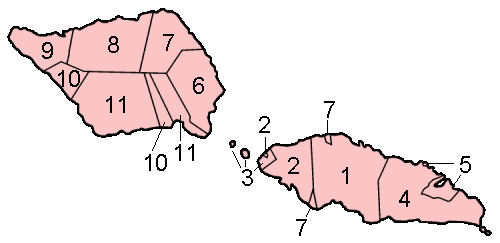
Political districts of Samoa, including minor islands
Samoa comprises eleven itūmālō (political districts). These are the traditional eleven districts which predate European arrival. Each district has its own constitutional foundation (faavae) based on the traditional order of title precedence found in each district's faalupega (traditional salutations).[55]
The capital village of each district administers and coordinates the affairs of the district and confers each district's paramount title, amongst other responsibilities.
For example, the District of A'ana has its capital at Leulumoega.
The paramount title of A'ana is the TuiA'ana.
The orator group which confers this title – the Faleiva (House of Nine) – is based at Leulumoega.
This is also the same for the other districts.
In the district of Tuamasaga, the paramount title of the district – the Malietoa title – is conferred by the FaleTuamasaga based in Afega.
The eleven itūmālō are identified to be:
OnUpolu
OnSavai'i
1 including the faipule district of Siumu 2 including islands Manono, Apolima and Nu'ulopa 3 including the Aleipata Islands and Nu'usafe'e Island 4 smaller parts also on Upolu (Salamumu, incl. Salamumu-Uta and Leauvaa villages)
Human rights
Major areas of concern include the under-representation of women, domestic violence and poor prison conditions.
Homosexual acts are illegal in Samoa.[56]
Christian revival
In June 2017, an Act was passed changing the country's constitution to include a reference to the Trinity. As amended, Article 1 of the Samoan Constitution states that “Samoa is a Christian nation founded of God the Father, the Son and the Holy Spirit”. According to The Diplomat, "What Samoa has done is shift references to Christianity into the body of the constitution, giving the text far more potential to be used in legal processes."[2] The preamble to the constitution already described the country as "an independent State based on Christian principles and Samoan custom and traditions."[2]
Geography
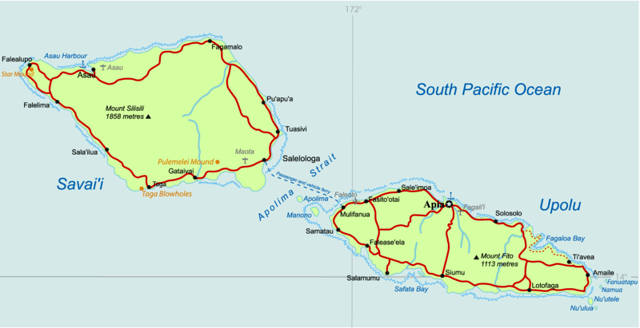
A map of Samoa.

Topography of Samoa.
Samoa lies south of the equator, about halfway between Hawaii and New Zealand, in the Polynesian region of the Pacific Ocean. The total land area is 2,842 km2 (1,097 sq mi),[58] consisting of the two large islands of Upolu and Savai'i (which together account for 99% of the total land area) and eight small islets.
The islets are:[59]
the three islets in the Apolima Strait (Manono Island, Apolima and Nu'ulopa)
the four Aleipata Islands off the eastern end of Upolu (Nu'utele, Nu'ulua, Namua, and Fanuatapu)
Nu'usafe'e, which is less than 1 hectare (2½ acres) in area and lies about 1.4 km (0.9 mi) off the south coast of Upolu at the village of Vaovai
The main island of Upolu is home to nearly three-quarters of Samoa's population, and to the capital city, Apia.
The Samoan islands result geologically from volcanism, originating with the Samoa hotspot, which probably results from a mantle plume.[60][61] While all of the islands have volcanic origins, only Savai'i, the westernmost island in Samoa, remains volcanically active, with the most recent eruptions at Mt Matavanu (1905–1911), Mata o le Afi (1902) and Mauga Afi (1725). The highest point in Samoa is Mt Silisili, at 1858 m (6,096 ft). The Saleaula lava fields situated on the central north coast of Savai'i result from the Mt Matavanu eruptions, which left 50 km2 (20 sq mi) of solidified lava.[62]
Savai'i is the largest of the Samoan islands and the sixth-largest Polynesian island (after New Zealand's North, South and Stewart Islands and the Hawaiian islands of Hawaiʻi and Maui). The population of Savai'i is 42,000 people.
Climate
Samoa has an equatorial/monsoonal climate, with an average annual temperature of 26.5 °C (79.7 °F) and a rainy season from November to April.[63]
| Climate data for Apia | |||||||||||||
|---|---|---|---|---|---|---|---|---|---|---|---|---|---|
| Month | Jan | Feb | Mar | Apr | May | Jun | Jul | Aug | Sep | Oct | Nov | Dec | Year |
| Average high °C (°F) | 30.4(86.7) | 30.6(87.1) | 30.6(87.1) | 30.7(87.3) | 30.4(86.7) | 30.0(86.0) | 29.5(85.1) | 29.6(85.3) | 29.9(85.8) | 30.1(86.2) | 30.3(86.5) | 30.5(86.9) | 30.2(86.4) |
| Average low °C (°F) | 23.9(75.0) | 24.2(75.6) | 24.0(75.2) | 23.8(74.8) | 23.4(74.1) | 23.2(73.8) | 22.6(72.7) | 22.8(73.0) | 23.1(73.6) | 23.4(74.1) | 23.6(74.5) | 23.8(74.8) | 23.5(74.3) |
| Averageprecipitationmm (inches) | 489.0(19.25) | 368.0(14.49) | 352.1(13.86) | 211.2(8.31) | 192.6(7.58) | 120.8(4.76) | 120.7(4.75) | 113.2(4.46) | 153.9(6.06) | 224.3(8.83) | 261.7(10.30) | 357.5(14.07) | 2,965(116.72) |
| Source:World Meteorological Organization(UN)[64] | |||||||||||||
Ecology
Samoa forms part of the Samoan tropical moist forests ecoregion. Since human habitation began, about 80% of the lowland rainforests have disappeared. Within the ecoregion about 28% of plants and 84% of land birds are endemic.[65]
Economy
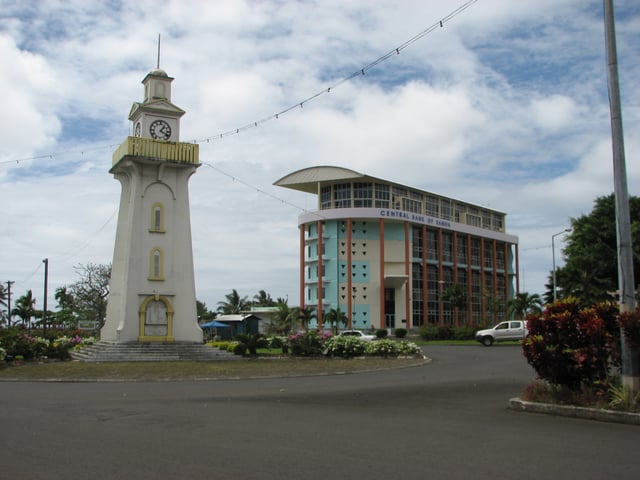
Central Bank of Samoa

Taro, a root crop, traditionally was Samoa's largest export, generating more than half of all export revenue in 1993. A fungal blight decimated the plants, and in each year since 1994 taro exports have accounted for less than 1% of export revenue.
The United Nations has classified Samoa as an economically developing country since 2014.[66] In 2017, Samoa's gross domestic product in purchasing power parity was estimated to be $1.13 billion U.S. dollars, ranking 204th among all countries. The services sector accounted for 66% of GDP, followed by industry and agriculture at 23.6% and 10.4%, respectively.[1] The same year, the Samoan labour force was estimated at 50,700.[1]
The country's currency is the Samoan tālā, issued and regulated by the Central Bank of Samoa.[68] The economy of Samoa has traditionally been dependent on agriculture and fishing at the local level.
In modern times, development aid, private family remittances from overseas, and agricultural exports have become key factors in the nation's economy. Agriculture employs two-thirds of the labour force and furnishes 90% of exports, featuring coconut cream, coconut oil, noni (juice of the nonu fruit, as it is known in Samoan), and copra.[1]
Outside of a large automotive wire harness factory (Yazaki Corporation which ended production in August 2017[69]), the manufacturing sector mainly processes agricultural products. Tourism is an expanding sector which now accounts for 25% of GDP. Tourist arrivals have been increasing over the years with more than 100,000 tourists visiting the islands in 2005, up from 70,000 in 1996.
The Samoan government has called for deregulation of the financial sector, encouragement of investment, and continued fiscal discipline. Observers point to the flexibility of the labour market as a basic strength for future economic advances. The sector has been helped enormously by major capital investment in hotel infrastructure, political instability in neighbouring Pacific countries, and the 2005 launch of Virgin Samoa a joint-venture between the government and Virgin Australia (then Virgin Blue).
In the period before German colonisation, Samoa produced mostly copra.
German merchants and settlers were active in introducing large scale plantation operations and developing new industries, notably, cocoa bean and rubber, relying on imported labourers from China and Melanesia. When the value of natural rubber fell drastically, about the end of the Great War (World War I), the New Zealand government encouraged the production of bananas, for which there is a large market in New Zealand.
Because of variations in altitude, a large range of tropical and subtropical crops can be cultivated, but land is not generally available to outside interests.
Of the total land area of 2,934 km2 (725,000 acres), about 24.4% is in permanent crops and another 21.2% is arable.
About 4.4% is Western Samoan Trust Estates Corporation (WSTEC).
The staple products of Samoa are copra (dried coconut meat), cocoa bean (for chocolate), and bananas. The annual production of both bananas and copra has been in the range of 13,000 to 15,000 metric tons (about 14,500 to 16,500 short tons). If the rhinoceros beetle in Samoa were eradicated, Samoa could produce in excess of 40,000 metric tons (44,000 short tons) of copra. Samoan cocoa beans are of very high quality and used in fine New Zealand chocolates. Most are Criollo-Forastero hybrids. Coffee grows well, but production has been uneven. WSTEC is the biggest coffee producer. Rubber has been produced in Samoa for many years, but its export value has little impact on the economy.
Other agricultural industries have been less successful.
Sugarcane production, originally established by Germans in the early 20th century, could be successful. Old train tracks for transporting cane can be seen at some plantations east of Apia. Pineapples grow well in Samoa, but beyond local consumption have not been a major export.
Sixty percent of Samoa's electricity comes from renewable hydro, solar, and wind sources, with the remainder from diesel generators.
The Electric Power Corporation has a goal of 100% renewable energy by 2021.[70]
Demographics
Ethnic groups
92.6% of the population are Samoans, 7% Euronesians (people of mixed European and Polynesian ancestry) and 0.4% are Europeans, according to the CIA World Factbook.
Only the Māori of New Zealand outnumber Samoans among Polynesian groups.
Languages
- *Further information:
Samoan (Gagana Fa'asāmoa) and English are the official languages. Including second-language speakers, there are more speakers of Samoan than English in Samoa.[71] Samoan Sign Language is also commonly used among the deaf population of Samoa. To emphasize the importance of full inclusion with sign language, elementary Samoan Sign Language was taught to members of the Samoa Police Service, Red Cross Society, and public during the 2017 International Week of the Deaf.[72]
Religion
Since 2012, Article 1 of the Samoan Constitution states that “Samoa is a Christian nation founded of God the Father, the Son and the Holy Spirit”.[2]
Samoans' religious adherence includes the following: Christian Congregational Church of Samoa 31.8%, Roman Catholic 19.4%, Methodist 15.2%, Assembly of God 13.7%, The Church of Jesus Christ of Latter-day Saints 7.6%, Seventh-day Adventist 3.9%, Worship Centre 1.7%, other Christian 5.5%, other 0.7%, none 0.1%, unspecified 0.1% (2011 estimate).[1] The Head of State until 2007, His Highness Malietoa Tanumafili II, was a Bahá'í. Samoa hosts the seventh (of nine current) Bahá'í Houses of Worship in the world; completed in 1984 and dedicated by the Head of State, it is located in Tiapapata, 8 km (5 mi) from Apia.
Education
The Samoan government provides eight years of primary and secondary education that is tuition-free and is compulsory through age 16.[73]
In Samoa primary education is free, which includes grades 1-8, Ages 6–13, and is a total of 6 years.
After primary education comes middle school which is also free and is only 2 years.
After 8 years students are required to take a national exam which ranks them for selection into secondary schools.
Once the students are in secondary school everything is taught to them in English and they also have to pay yearly tuition, which is $60 for Samoan citizens and $150 for non Samoan citizen students.
Samoa's main post-secondary educational institution is the National University of Samoa, established in 1984. The country is also home to several branches of the multi-national University of the South Pacific and the Oceania University of Medicine.[74]
Education in Samoa has proved to be effective as a 2012 UNESCO report stated that 99 per cent of Samoan adults are literate.[75]
Culture
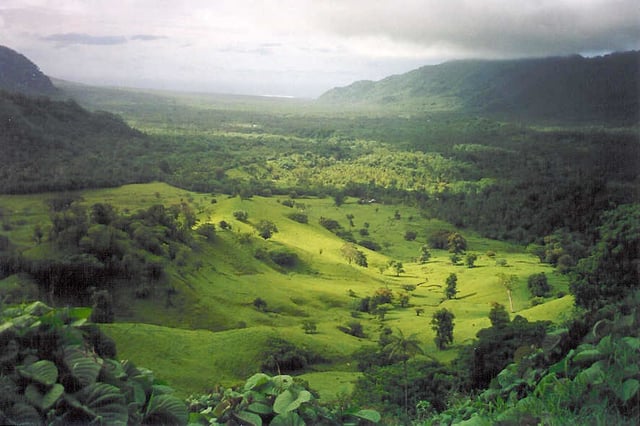
A view of Falefa Valley from Le Mafa Pass, east Upolu.
The fa'a Samoa, or traditional Samoan way, remains a strong force in Samoan life and politics. Despite centuries of European influence, Samoa maintains its historical customs, social and political systems, and language. Cultural customs such as the Samoa 'ava ceremony are significant and solemn rituals at important occasions including the bestowal of matai chiefly titles. Items of great cultural value include the finely woven 'ie toga
Samoan mythology includes many gods with creation stories and figures of legend such as Tagaloa and the goddess of war Nafanua, the daughter of Saveasi'uleo, ruler of the spirit realm Pulotu. Other legends include the well known story of Sina and the Eel which explains the origins of the first coconut tree.
Some Samoans are spiritual and religious, and have subtly adapted the dominant religion of Christianity to 'fit in' with fa'a Samoa and vice versa.
Ancient beliefs continue to co-exist side-by-side with Christianity, particularly in regard to the traditional customs and rituals of fa'a Samoa.
The Samoan culture is centred around the principle of vāfealoa'i, the relationships between people.
These relationships are based on respect, or fa'aaloalo.
When Christianity was introduced in Samoa, most Samoan people converted.
Currently 98% of the population identify themselves as Christian.
Some Samoans live a communal way of life, participating in activities collectively.
Examples of this are the traditional Samoan fale
The Samoan siva dance has unique gentle movements of the body in time to music and tells a story, although the Samoan male dances can be more snappy.[76] The sasa is also a traditional dance where rows of dancers perform rapid synchronised movements in time to the rhythm of wooden drums pate) or rolled mats. Another dance performed by males is called the fa'ataupati
The form and construction of traditional architecture of Samoa was a specialised skill by Tufuga fai fale that was also linked to other cultural artforms.
Tattooing

A Samoan woman with a traditional malu.
As with other Polynesian cultures (Hawaiian, Tahitian and Māori) with significant and unique tattoos, Samoans have two gender specific and culturally significant tattoos. For males, it is called the Pe'a and consists of intricate and geometrical patterns tattooed that cover areas from the knees up towards the ribs. A male who possesses such a tatau is called a soga'imiti. A Samoan girl or teine is given a malu, which covers the area from just below her knees to her upper thighs.[77]
Contemporary culture
Albert Wendt is a significant Samoan writer whose novels and stories tell the Samoan experience. In 1989, his novel Flying Fox in a Freedom Tree was made into a feature film in New Zealand, directed by Martyn Sanderson.[78] Another novel Sons for the Return Home had also been made into a feature film in 1979, directed by Paul Maunder.[79] The late John Kneubuhl, born in American Samoa, was an accomplished playwright and screenwriter and writer. Sia Figiel won the 1997 Commonwealth Writers' Prize for fiction in the south-east Asia/South Pacific region with her novel "Where We Once Belonged". Momoe Malietoa Von Reiche is an internationally recognised poet and artist. Tusiata Avia is a performance poet. Her first book of poetry Wild Dogs Under My Skirt was published by Victoria University Press in 2004. Dan Taulapapa McMullin is an artist and writer. Other Samoan poets and writers include Sapa'u Ruperake Petaia, Eti Sa'aga and Savea Sano Malifa, the editor of the Samoa Observer.
In music, popular local bands include The Five Stars, Penina o Tiafau and Punialava'a. The Yandall Sisters' cover of the song Sweet Inspiration reached number one on the New Zealand charts in 1974. King Kapisi was the first hip hop artist to receive the prestigious New Zealand APRA Silver Scroll Award in 1999 for his song Reverse Resistance. The music video for Reverse Resistance was filmed in Savai'i at his villages. Other successful Samoan hip hop artists include rapper Scribe, Dei Hamo, Savage and Tha Feelstyle whose music video Suamalie was filmed in Samoa.
Lemi Ponifasio is a director and choreographer who is prominent internationally with his dance Company MAU.[80] Neil Ieremia's company Black Grace has also received international acclaim with tours to Europe and New York. Hip hop has had a significant impact on Samoan culture. According to Katerina Martina Teaiwa, PhD from the University of Hawaii at Manoa, "Hip hop culture in particular is popular amongst Samoan youth."[81] As in many other countries, hip hop music is popular. In addition, the integration of hip hop elements into Samoan tradition also "testifies to the transferability of the dance forms themselves," and to the "circuits through which people and all their embodied knowledge travel."[82] Dance both in its traditional form and its more modern forms has remained a central cultural currency to Samoans, especially youths.[81]
The arts organisation Tautai is a collective of visual artists including Fatu Feu'u, Johnny Penisula, Shigeyuki Kihara, Michel Tuffery, and Lily Laita.[83]
Director Sima Urale is an award-winning filmmaker. Urale's short film O Tamaiti won the prestigious Best Short Film at the Venice Film Festival in 1996. Her first feature film Apron Strings opened the 2008 NZ International Film Festival. The feature film Siones Wedding, co-written by Oscar Kightley, was financially successful following premieres in Auckland and Apia. The 2011 film The Orator was the first ever fully Samoan film, shot in Samoa in the Samoan language with a Samoan cast telling a uniquely Samoan story. Written and directed by Tusi Tamasese, it received much critical acclaim and attention at film festivals throughout the world.
Sport
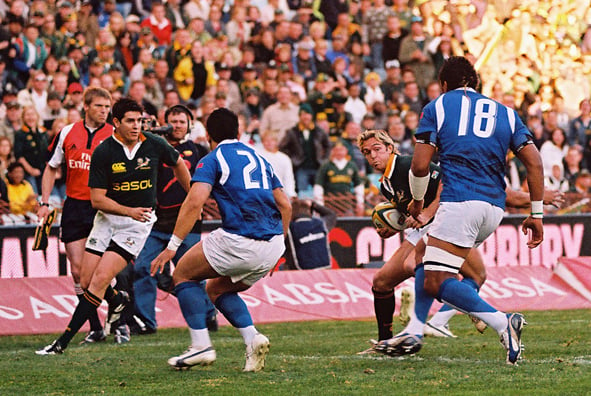
Samoa (blue) vs. South Africa in June 2007.
The main sports played in Samoa are rugby union, Samoan cricket and netball. Rugby union is the national football code of Samoa. In Samoan villages, volleyball is also popular.
Rugby union is the national sport in Samoa and the national team, nicknamed the Manu Samoa, is consistently competitive against teams from vastly more populous nations. Samoa has competed at every Rugby World Cup since 1991, and made the quarter finals in 1991, 1995 and the second round of the 1999 World Cup.[84] At the 2003 world cup, Manu Samoa came close to beating eventual world champions, England. Samoa also played in the Pacific Nations Cup and the Pacific Tri-Nations. The sport is governed by the Samoa Rugby Football Union, who are members of the Pacific Islands Rugby Alliance, and thus, also contribute to the international Pacific Islanders rugby union team.
At club level, there is the National Provincial Championship and Pacific Rugby Cup. They also took home the cup at Wellington and the Hong Kong Rugby Sevens in 2007—for which the Prime Minister of Samoa, also Chairman of the national rugby union, Tuila’epa Sa’ilele Malielegaoi, declared a national holiday. They were also the IRB World Sevens Series Champions in 2010 capping a year of achievement for the Samoans, following wins in the US, Australia, Hong Kong and Scotland Sevens tournaments.
Prominent Samoan players include Pat Lam and Brian Lima. In addition, many Samoans have played for or are playing for New Zealand.
Rugby league is mostly played by Samoans living in New Zealand and Australia. Samoa reached the quarter finals of the 2013 Rugby League World Cup, the team comprising players from the NRL and Super League plus domestic players. Many Samoans and New Zealanders or Australians of Samoan descent play in the Super League and National Leagues in Britain, including Francis Meli, Ta'ane Lavulavu of Workington Town, Maurie Fa'asavalu of St Helens and David Fatialofa of Whitehaven and Setima Sa who signed with London Irish rugby club. Other noteworthy players from NZ and Australia have represented the Samoan National team. The 2011 domestic Samoan rugby league competition contained 10 teams with plans to expand to 12 in 2012.[85]
Samoans have been very visible in boxing, kickboxing, wrestling, and sumo; some Samoan sumo wrestlers, most famously Musashimaru and Konishiki, have reached the highest rank of Ozeki and yokozuna
American football is occasionally played in Samoa, reflecting its wide popularity in American Samoa, where the sport is played under high school sanction. About 30 ethnic Samoans, many from American Samoa, currently play in the National Football League. A 2002 article from ESPN estimated that a Samoan male (either an American Samoan or a Samoan living in the mainland United States) is 40 times more likely to play in the NFL than a non-Samoan American.[86]
See also
Outline of Samoa

